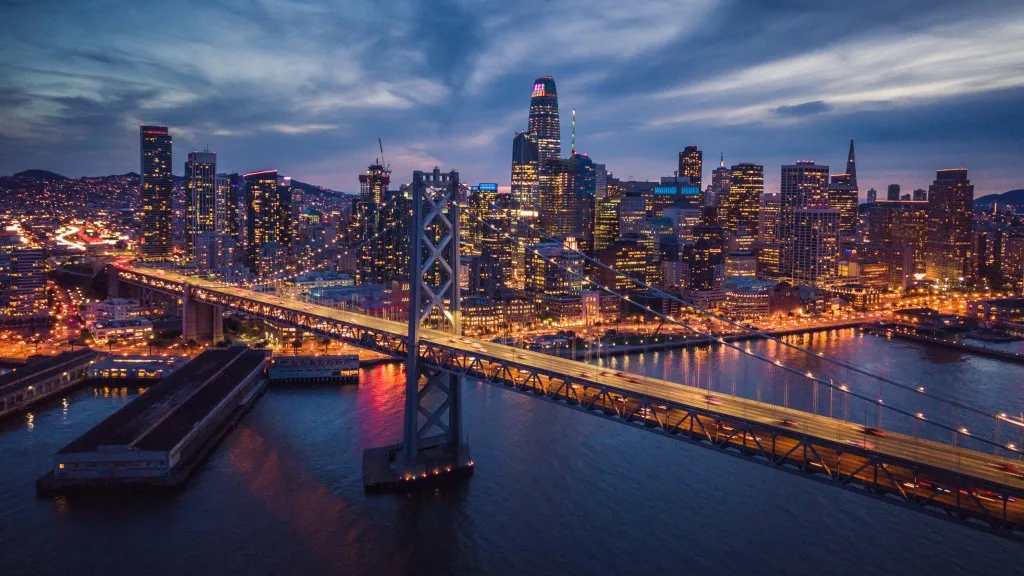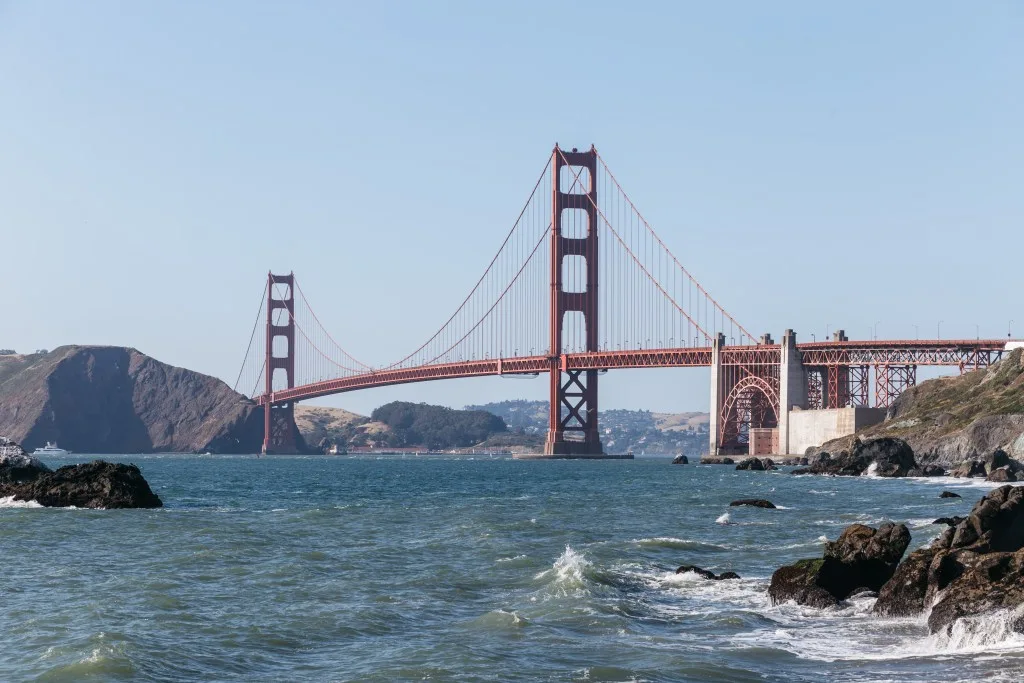Swimming in open waters is an adventure, especially when you don’t know what’s out there (or, rather, what’s at the bottom). And when we’re talking about San Francisco Bay, the curiosities of what’s at the bottom of the Bay abound.
Could it be sunken treasures from the past prisoners of Alcatraz? Maybe it’s the prisoners themselves at the bottom? How about Jaws?
We’ve got the facts about what’s at the bottom of San Francisco Bay. We also have a few more tidbits of fun information about San Francisco’s famous – or should we say infamous – Bay.
What Is the San Francisco Bay?
San Francisco Bay is off the coast of California’s fourth most populous city, San Francisco. Centrally located along the coast, many people think of San Francisco Bay as being the same as the Pacific Ocean.
While the ocean is a part of the waters that make up this body of water, the Bay is in the middle of Oakland, San Mateo, San Jose, and San Francisco. San Pablo Bay connects with it at its northern point. Additionally, those two major bays, the Pacific Ocean, and several waterways combine to make up what people consider San Francisco Bay.
The Golden Gate Bridge, over the Golden Gate Strait, acts as the doorway from the Bay to the ocean, making this body of water seem more like a lake than a bay.
Although not a lake, its size is reminiscent of one. Covering around 1,600 square miles, the entire Bay Area of water is the largest estuary in the Americas. The San Francisco Bay is around 8 miles wide and 50 miles north to south.
Different Inhabitants
The Native American group, Ohlone, is believed to have been in the Bay Area since around 500 AD. It wasn’t until the mid-1700s that a European explorer laid eyes upon the Bay atop a nearby mountain. About a century later, Spanish explorers first started venturing into the area and creating European settlements, and it was then that the great fill began.
Explorers, wanting more land to profit from, attempted to fill in the waterways, tearing down natural wetlands. Continuing into the 20th century, pollution and natural disasters continued to block riverways and wetlands.
Today, many agencies are working together to bring back the wetlands and prevent more pollution from entering the Bay. Despite the changes over the centuries, San Francisco Bay has been an important waterway for tourists and businesses.
What Is the San Francisco Bay Known For?
Many know San Francisco Bay and its surrounding cities mostly for tourism. Home to three major cities – San Francisco, San Jose, and Oakland – millions of tourists flock here to mingle with the millions of residents around the area.
We know San Francisco Bay and the Bay Area for the world-famous prison, Alcatraz, and the Golden Gate Bridge. The area is also known for its seafood, fine dining, the surrounding wine country, and rolling hills. Of course, it’s also known for its coastal waters, fishing, boating, surfing, and strolling along its many scenic waterways.
With hundreds of miles of water home to more than 500 species of fish and wildlife, the cities and the bay waters are bustling with activity. Not only that, but San Francisco Bay is one of the four largest ports on the Pacific Coast, making it a busy access point for shipping and other business entities.
Pro Tip: Get out into nature and enjoy one of these 7 Great San Francisco Bay Area Hikes.

What’s at the Bottom of San Francisco Bay?
But what San Francisco Bay might really be known for is the curiosity about what’s at the bottom of the Bay. And as some might think, yes, there’s a sunken ship, along with some tombstones (maybe from Alcatraz). Of course, you’ll find sharks, other sea life, and a few unexpected items, like huge rocks.
The City of Chester Steamship
Wouldn’t it be fantastic if a city was really under San Francisco Bay? Don’t get too excited. The City of Chester Steamship is just the name of the ship at the bottom, not an entire city. But it’s still quite intriguing to know that a passenger steamship lies beneath it.
In 1888, this passenger ship crashed into the RMS Oceanic due to dense fog overtaking the Bay. The City of Chester Steamship sank with 16 people within six minutes of the collision. Today, it sits upright in one of the deepest parts of the Bay at 216 feet underwater near the Golden Gate Bridge.
And that’s not the only ship that sank in the San Francisco Bay. Supposedly there have been over 200 shipwrecks here. However, most of them are out of the Bay and are no longer underwater.
Tombstones
In San Francisco Maritime National Historic Park lies Aquatic Park, a part of San Francisco Bay. It’s here where many tombstones have been discarded and now lie at the bottom of the Bay.
But how did tombstones end up at the bottom of San Francisco Bay? In the early 1900s, the area cemeteries had run out of space. Authorities then moved the bodies from the city’s wild west days to mass graves in Colma, resulting in many unclaimed tombstones. Those tombstones ultimately ended up in a rubble pile meant for new building projects. Today, you can find these unclaimed tombstones along the water’s edge as path liners at Aquatic Park and Buena Vista Park.
Large Rocks
We imagine you probably expect a lot of large rocks in the water here, just like any large body of water. But these large rocks are a bit unique.
Believed to have come from an ancient submerged mountain ridge, these rocks were in the way and once wreaked havoc on passing ships. In the early 1900s, officials blew up many of them into smaller pieces because of this. Now there are pieces of them throughout the Bay.
And while blowing them up may have stopped some catastrophes in the early 1900s, ships keep getting bigger. Today, some of these large rocks still cause problems for the massive tankers coming through. To prevent additional problems, the channels in the Bay are dredged regularly to prevent silt from building up in the shipping lanes.
Sharks
Twelve shark species have been known to reside in San Francisco Bay, including the Great White. But the most common shark here is the Leopard Shark. It only reaches about 5 feet in length and has a diet of mostly worms, crabs, and small fish. You won’t have too much to worry about when it comes to the sharks in this bay.

What Is the Deepest Part of San Francisco Bay?
Speaking of creatures living on the ocean floor, you might be curious about how deep San Francisco Bay is. And in reality, on average, it’s not deep at all. In fact, its average depth is anywhere between 12 feet and 15 feet deep. Many other places are even shallower than that. Think swimming pool deep.
However, under the Golden Gate Bridge, San Francisco Bay is the deepest. At around 370 feet deep, this might just be where your curiosity gets the best of you. Can you see those tombstones swarming with sharks deep down in the depths of the bay? We thought so.
Can You Swim in the San Francisco Bay?
While much of the Bay is shallow but deep enough for a swim, most people don’t consider this body of water ideal for swimming. However, plenty of swimmers embark upon the adventure of swimming in it. Keep in mind, though, most of these adventurers are that – adventurers. Swimming in the bay isn’t a casual beach summer day affair.
With an average 50-degree water temperature, you’ll need some planning and expertise. Most swimmers here go with groups and have wetsuits, goggles, swim caps, and a plan. There are those who will swim to Alcatraz. Some will swim under the Golden Gate Bridge, and some will stay a bit closer to shore.
But while you can swim in San Francisco Bay, it doesn’t mean you should. If you’re looking for a casual summer dip in the water to relax and cool off, there are plenty of other places in the Bay Area to do just that. Maybe we should leave the actual bay to the sharks.
Pro Tip: Unsure whether or not you want to visit San Francisco? These 5 Reasons to Avoid San Francisco may help you make up your mind.
Is San Francisco Bay Worth Visiting?
Do you want to be surrounded by vibrant cities full of culture and nature with the history of the land and the water in the entire San Francisco Bay Area? We’d say San Francisco Bay is worth visiting.
Not only will you experience all that the metropolis has to offer, but the beauty of the wetlands, the coastal waters, and the many freshwater points make up the entire Bay Area you’ll only see in many places.
You may never see the buried steamship and tombstones, and hopefully never a shark. But, you’ll see plenty when visiting this coastal California waterway.
Discover the Best Free Camping Across the USA
To be honest with you, we hate paying for camping. There are so many free campsites in America (with complete privacy).
You should give it a try!
As a matter of fact, these free campsites are yours. Every time you pay federal taxes, you’re contributing to these lands.
Become a FREE CAMPING INSIDER and join the 100,000 campers that love to score the best site!
We’ll send you the 50 Best Free Campsites in the USA (one per state). Access the list by submitting your email below: